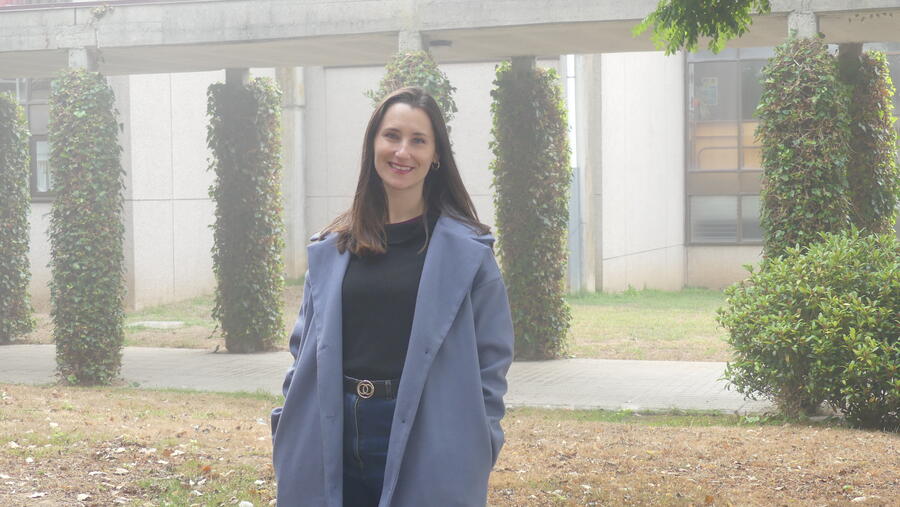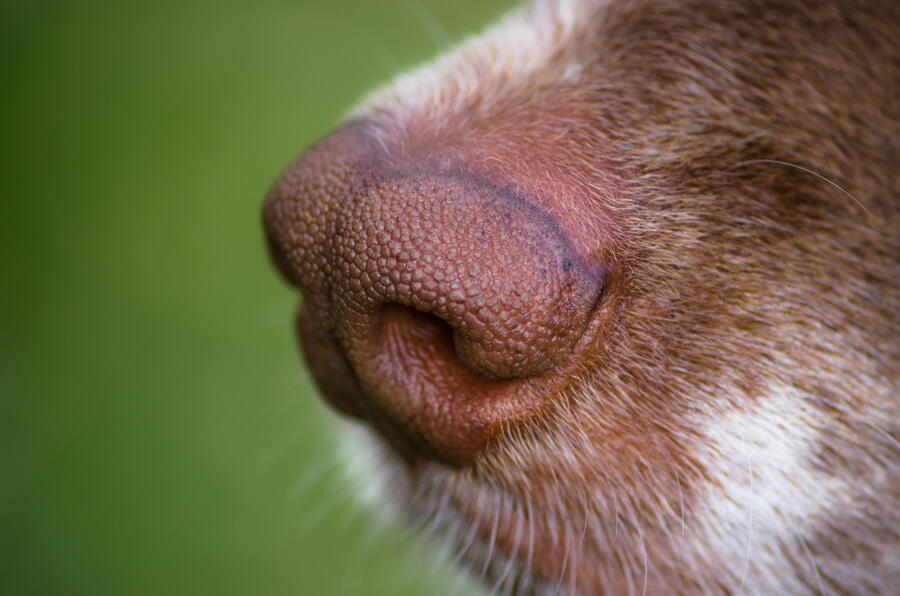Irene Ortiz Leal: «My final degree project was the seed for my doctoral thesis and my continued research career»

Irene Ortiz Leal, Assistant Professor of Anatomy at the Faculty of Veterinary Science on the Campus Terra (USC), combines a dual background in Pharmacy and Veterinary Medicine with a PhD in Neuroanatomy, which enables her to bridge the molecular, experimental, and clinical fields. Her thesis compared the olfactory and vomeronasal systems in dogs, wolves, and foxes, revealing less sensory development in domestic dogs, which is linked to domestication and the selection of social traits. These results, which have had a significant impact and generated substantial scientific output, reinforce a central idea: domestication also transforms the brain and sensory abilities.
Her research agenda prioritizes a comparative approach to smell and chemical communication in multiple species to better understand both animal biology and the basis of human smell. Stints at the Max Planck Institute, the University of Edinburgh and the Freie Universität Berlin expanded her methodological toolbox and forged essential collaborations.
At the same time, her teaching focuses on participatory practical sessions, anatomical models, connections with other subjects and the future exploration of innovative formats (mentoring, podcasts, flipped classrooms) to maintain student motivation.
This interview is a fascinating journey through her professional career...
-Your training combines Pharmacy and Veterinary Medicine, as well as a PhD in Neuroanatomy. How did this dual perspective influence your approach to research and teaching in anatomy?
-Of course, my training in Veterinary Science was fundamental to my research and teaching in anatomy. In this way, my degree provided me with a broad, applied, and comparative education in anatomy, where I was able to discover the great diversity that exists between species and the relationship between structure and function in both academic and clinical contexts.
On the other hand, my training in Pharmacy provided me with knowledge of Biochemistry and Physiology at the molecular level, which proved to be fundamental when I started anatomy. In the laboratory, we work with anatomical structures as well as their relationships through receptors and their transduction chains.
In addition, my degree in Pharmacy provided me with a very comprehensive foundation in laboratory management, which complemented my experience and facilitated my approach to research. Thanks to this, I was able to handle widely used techniques with greater confidence, such as immunohistochemistry, dilution calculations, and statistical methods for analysing results. Looking back, I believe that my degree in Pharmacy was indispensable to my training; above all, together with Veterinary Medicine and my approach to research in my final degree project, it was the seed of my passion for research.
The knowledge and skills acquired in both degrees converged in my PhD in Neuroanatomy, enabling me to integrate molecular, experimental, and applied knowledge, as well as helping me formulate broader questions, ranging from the microscopic to the macroscopic level.
In teaching, the knowledge from both degrees allows me to convey anatomy as a discipline directly related to physiology and clinical practice, which is essential for students' understanding of the concepts and, above all, for their motivation to learn.
-Your thesis focused on the comparative neuroanatomy of the olfactory and vomeronasal systems in canids. What are the main findings of this work, and what do they contribute to our knowledge of animal domestication?
-The study compared the morphology and functionality of the olfactory and vomeronasal systems (the system responsible for the perception of pheromones and other chemical compounds) in domestic dogs, wolves and foxes. Our results showed that both wolves and foxes have a higher degree of development in these systems than domestic dogs. This difference is evident in both the anatomical structures that detect molecules (neuroepithelium) and the brain areas that process information (olfactory bulbs).
These findings suggest that the process of dog domestication not only altered physical and behavioural characteristics, but also had a significant effect on the brain, and on these structures in particular. The reduced olfactory and vomeronasal sensory capacity of dogs, compared to their wild relatives, may be a consequence of artificial selection. During domestication, humans prioritized abilities such as docility and sociability over other skills, including olfaction. Therefore, it seems logical to think that this involution of the olfactory systems could be related to the fact that dogs no longer need to rely so heavily on their sense of smell for hunting, territorial defence or finding a mate, as humans take care of many of these needs.
These findings may help to better understand how domestication is a process that affects the biology of a species at a functional level, not just in its appearance or behavior, and how this entire process, along with the influence of humans, has allowed the evolution of sensory abilities in domestic animals.
In short, I am very happy with the results of my thesis and its impact; various media outlets reported on the results, such as Diario Veterinario, Animal's
Health, La Voz de Galicia and El Progreso; and from the results of the thesis we were able to publish six directly related scientific articles, as well as eight contributions to scientific conferences related to the results.

-In the past, you have spent time at prestigious institutions such as the Max Planck Institute, the University of Edinburgh and the Freie Universität Berlin. What impact did these experiences have on your research and teaching development?
-My stays at prestigious centres such as the Max Planck Institute, the University of Edinburgh and the Freie Universität Berlin were and continue to be essential to my professional development, as, from a research point of view, they help me to broaden my scientific vision by exposing me to new perspectives, methodologies and approaches to work that enrich the way I approach my work. In addition, I gained firsthand knowledge of cutting-edge technologies and infrastructures to which I did not previously have access, which was fundamental in enriching my perspective applied to my own research and which, in the future, may complement our work.
Finally, it is essential to note that these stays are crucial for establishing collaborative networks with renowned scientists and participating in high-level joint projects, which foster professional ties that are vital to our current work.
From a teaching perspective, the international experience was equally enriching, as it allowed me to learn about new pedagogical strategies and teaching techniques, as well as didactic approaches that help to formulate teaching differently. In addition, I was able to learn about the use of varying conservation materials and techniques, and to employ different work and teaching organisation schemes, which can significantly improve the management and planning of my teaching work in the future.
In short, spending time at different national and international centres is enriching from multiple perspectives: it strengthens research work, promotes the establishment of collaborations and has a positive impact on teaching. That is why I consider institutional support, both corporate and financial, to be essential, not only to enable but also to encourage all teachers who wish to do so to undertake this type of experience.
-With more than 15 articles in high-impact journals and numerous conference presentations, what lines of research are currently a priority on your academic agenda?
-My priorities are mainly focused on advancing the study of the olfactory and vomeronasal systems in different species, a field with enormous potential and still many unknowns to be resolved. The comparative perspective is very interesting, as these systems are extremely varied, even among phylogenetically closely related animals of the same family or genus, which allows us to understand better how these systems work and, beyond the mouse model, to gain a better understanding of the morphological and functional bases of the human olfactory system.
-As an assistant professor of anatomy in the Faculty of Veterinary Medicine, what methodologies do you use to motivate students and facilitate their understanding of a discipline as visual and practical as anatomy?
-This is a key question, as I believe that one of the main problems we encounter is student motivation. They start the degree with a lot of motivation, and even begin anatomy classes with the same enthusiasm, but as the course progresses, that initial motivation is lost. It is logical to think that they may feel overwhelmed by the vast amount of information from various disciplines. Therefore, I believe it is very important for students to feel motivated and involved from the very beginning of the classes, presenting the information in different ways, such as using various anatomical models during the practical sessions, in addition to the script and dissection samples, which allow them to understand the structures better and internalise their spatial organisation. In addition, we try to connect anatomy with other disciplines in the degree programme, so that they perceive its real applicability and importance in both clinical practice and research.
The sessions are always dynamic and participatory, especially the practical ones, in which I believe students mustn't be mere recipients of knowledge, but active participants in the learning process. We always encourage their participation in dissections and the handling of samples, and we encourage them to be involved in their learning process.
Currently, I am also considering incorporating other innovative techniques in the future, such as mentoring, which was successfully applied in Anatomy a few years ago with very good results and could once again be a valuable tool for reinforcing learning and motivation. In addition, I am open to exploring other innovative techniques, such as creating podcasts or implementing the flipped classroom, with the aim of continually improving motivation and understanding of the subject.
-You have supervised numerous final degree projects on a wide variety of species, from canids to reptiles. What criteria do you use to guide students in such diverse research projects?
-Supervising final degree projects (TFG) is very rewarding, not only because of the tutoring itself, but also because of introducing students to the world of research and the exciting world of neuroscience. For this, it is crucial that students feel motivated and that they believe their tutor will provide them with whatever support they need.
Therefore, one of the first criteria we follow in our research group is always to try to adapt, as far as possible, the research topics to their preferences, offering topics that cover different neuroanatomical structures such as the olfactory system, the amygdala or the hippocampus, and even accepting related projects but directly proposed by them, such as the study of the auditory system of rabbits, or species that they themselves contribute, such as geckos, sugar gliders, etc.
My main role, therefore, is not only to supervise but also to serve as a source of help and inspiration that motivates them to get involved in their project. The ultimate goal is for their first experiences in research to be as enriching and exciting as possible, so that they develop a genuine interest in science and that the knowledge they acquire will benefit them in their future professional lives.
In fact, in some cases, these initial research experiences have a direct and tangible impact on students' professional careers. In my own case, for example, my final degree project served as the seed for my doctoral thesis and my subsequent research career, ultimately leading to my securing a position as a doctoral assistant.
-How relevant do you think your anatomical research is, not only for veterinary medicine, but also for areas such as biomedicine, wildlife conservation, and environmental conservation?
-Our work focuses on the olfactory and vomeronasal systems, which have been shown to be essential in the chemical communication of animals and in the regulation of their socio-sexual behaviour. Thus, studies on various animals, such as dogs, foxes, rabbits, and mole rats, have allowed us to improve our understanding.
For example, when dogs have a non-functional or underdeveloped vomeronasal system, they are unable to adapt their behavior to their environment, exhibiting inappropriate behaviors and hindering their proper socialization with other individuals of their species.
Another example is our study on the impact of the parasite cefenemia on roe deer in Galicia, which lodges in the nasal cavity of these animals and causes significant changes in the respiratory and olfactory epithelia, potentially affecting their well-being.
Finally, the study of the vomeronasal system of the mole rat led to the design of promising strategies for the biological, sustainable and respectful control of the populations of this species, which is currently a major pest in crops not only in Galicia, but also in other regions, including France, destroying crops and degrading the land. This study, therefore, presents a strategy for the sustainable and effective conservation of our environment.

-What do you consider to be the main challenges in teaching and research in veterinary anatomy in the current university context?
-Currently, without a doubt, I consider the main challenge in both teaching and research in veterinary anatomy to be the lack of funding. Although Campus Terra has promoted its own initiatives to alleviate this shortfall, which are working very well, the available resources remain insufficient. The lack of stable funding lines or direct resources undermines the progress of projects, which in many cases must be approached from a more austere perspective and may even be temporarily halted while waiting for additional funds. This situation also hinders the recruitment of talent: the lack of research contracts for doctoral students makes it difficult for recent graduates to invest time and resources in completing their theses, thus undermining generational advancement in the academic and scientific fields.
In the field of teaching, another important challenge, as I mentioned earlier, is student motivation. In some cases, the perception that anatomy is a complex subject can hinder students' active involvement, as they often approach the subject with apprehension. It is therefore essential to seek strategies that encourage participation, highlighting the connection between the subject and other disciplines, thus demonstrating its clinical and research applicability.
-Your curriculum emphasises the idea of contributing to improving people's lives through scientific advancement. How does your work in neuroanatomy and comparative anatomy connect with that purpose?
-We study the olfactory systems: the traditional olfactory system and the vomeronasal system. In humans, for example, one of the big questions is how we, with only 400 olfactory receptors, are able to distinguish approximately one trillion different odours. How is this possible? Although it seems incredible, no one knows exactly how this happens, which contrasts with our understanding of other senses, such as sight or hearing, where we comprehend how they work and have been able to replicate them in cameras or microphones.
Understanding exactly how smell works is essential to improving people's lives, as deficiencies in olfactory abilities have a significant impact on their well-being and quality of life. We witnessed this during the COVID-19 pandemic, when thousands of people lost their sense of smell, with some cases being permanent.
In fact, the importance of anosmia, which is the inability to recognize smells, extends beyond the pandemic and is very prevalent in our society, as the loss of smell is often one of the first symptoms of neurodegenerative diseases such as Alzheimer's or Parkinson's. The study of the mechanisms that link these conditions to the olfactory system could have a direct impact on both the treatment and the development of olfactory tests for their early diagnosis, even before other symptoms appear.
Understanding all this is extremely complex. That is why one of our main objectives is to collaborate with researchers, both from USC itself and from other Spanish universities, as well as from outside Spain. The study of these systems requires access to different technologies, perspectives, and resources that can only be found through national and international collaboration networks.
-What projects or lines of research would you like to promote at Campus Terra in the coming years?
-In the coming years, my goal is to continue delving into the detailed study of the olfactory system and its impact on animal reproduction.
We aim to continue researching how chemical communication and odor perception influence reproductive behavior, as a precise understanding of these interactions is fundamental to the well-being and survival of species.
In this regard, my involvement in the project funded by the Ministry of Science, Innovation, and Universities aims to explore the morphological and functional mechanisms of chemical communication in rabbits, with the goal of directly applying this knowledge to enhance animal welfare and improve the productivity of rabbit farms.
In addition, the knowledge gained from this research is important for the future development of strategies for wildlife conservation and domestic animal management, as well as for a better understanding of human pathologies related to anosmia or sensory disorders.
